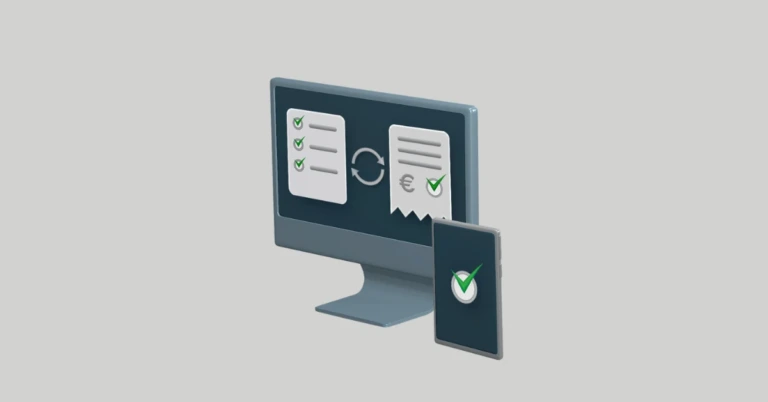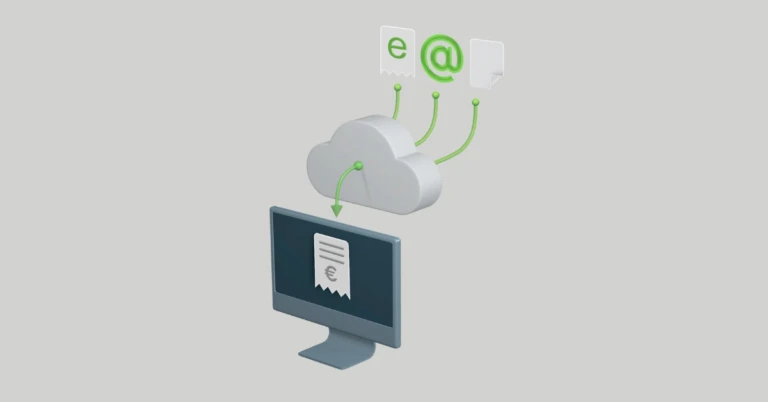
Peppol Orders in Sweden: Future-proof Your Business with Efficient Order Management and Digitalisation!
07.12.2023
Peppol messages are rapidly gaining traction in B2B and B2G communication, both in Sweden and internationally. The utilisation of Peppol requires system updates and skill development, but the international standard and its network offer significant potential to enhance the entire order-to-delivery chain. Companies engaging in Peppol orders in Sweden are positioned to benefit from a streamlined and efficient process, contributing to the growing adoption of this innovative communication standard.
What does ChatGPT have to say about Peppol? Let’s find out!
Let’s embrace modernity and utilize AI. We turn to ChatGPT to explore the possibilities with Peppol and ask about how to digitize one’s supply chain with Peppol. Here’s the response we received:
- Find a service provider offering a Peppol access point.
An access point connects you to the Peppol network, enabling the exchange of electronic documents with other parties.
- Integrate with the service provider.
Utilise standard communication.
- Register your unique electronic address.
Also known as Peppol-ID, with your service provider. A Peppol-ID identifies you in the network, acting like a “phone number” that allows you to send and receive documents.
- Choose the document types and formats for your transactions.
Peppol supports globally recognized standards, such as UBL and CII.
- Start sending and receiving documents with your partners via the Peppol network.
Gain access to a vast network of customers and suppliers in the public and private sectors within and beyond Europe.
This summary from ChatGPT provides a clear and concise overview of how to digitize your supply chain with Peppol, including the seamless integration of Peppol orders in Sweden. We continue our exploration by posing the following question:
If we digitize our supply chain, what benefits do we get?
We receive six advantages from ChatGPT, and here are our insights on them:
- Reduced Complexity and Dependency on Custom Electronic Formats.
Our customers have worked with various Edifact standards such as D96, D93, D911, managing the exchange of trade documents with different partners.
This entails unique formats and integrations contributing to significant complexity. Combining this with prior support for different systems like Svefaktura 1.0 and 2.0, XML in Denmark, and EHF in Norway – all of this adds to the challenging complexity.
With Peppol, this complexity is significantly reduced when it comes to maintaining and managing different formats and communication channels.
- Reuse of Standardised Electronic Documents Internationally.
Yes, the Peppol standard enables the exchange of various documents, such as Peppol orders and Peppol e-invoicing. A central aspect of Peppol is its uniformity – the documents look identical, which is the core of standardization. Before documents are sent over Peppol, they undergo validation to ensure accuracy. This requires compliance between the sender and receiver to guarantee that correct data is sent and received.
- Cost Reduction and Increased ROI on Electronic Commerce.
Our customers’ experiences indicate that the return on investment in electronic commerce is easier to realize. This is because the integration process takes less time, resulting in lower costs. Additionally, with the wide availability of Peppol access points in the market, there is competition leading to reduced costs for message traffic. This is of immense importance in keeping costs down.
- Simplified Buying and Selling for Both B2G and B2B.
Peppol simplifies the buying and selling processes for both B2G and B2B. While initially a requirement in the public sector, we observe its growing influence in the B2B realm in the current digital landscape, with expectations of continued expansion up to the year 2028.
- Compliance with EU Rules on E-Invoicing and E-Procurement.
We completely agree that embracing e-invoicing and e-procurement, such as Peppol e-invoicing, is crucial to complying with EU regulations in today’s business environment. Solutions like Peppol prove invaluable in streamlining and simplifying these processes.
- Switching Between Service Providers Without Losing Connections or Electronic Addresses.
The seamless transition between service providers while retaining connections and electronic addresses demonstrates Peppol’s impressive flexibility. It allows businesses to dynamically adapt without losing essential infrastructure.
One can summarise that it becomes much, much easier to get started with electronic commerce when using Peppol.
Per Åberg, Head of Business Network Products, OpusCapita
Efficientize IT with Peppol Standardization
Here, we present an image with bars, where the light green bar is a compilation of how the IT budget of the addressed companies looks. These funds represent the budget that can be used to support operations through various IT initiatives such as system integration, system replacements, upgrades, or other relevant IT investments.

Report from Deloitte – Finance Automation: The Future of Electronic Data Interchange (EDI).
The dark green bar illustrates the number of projects entering the IT department. One might imagine that 2017 was relatively stable, but looking at 2021, the IT department only has the time and resources to undertake 40% of what the business desires.
And why do we consider this a good example?
Peppol is a standard that enables versatile usage. Through Peppol, one avoids working with different formats for each customer and new integration for each new customer, streamlining the IT department and increasing returns from infrastructure investments. To maximize the potential of the IT department, standardization is a crucial step.
How does the market landscape look?
When discussing with various companies, it’s common to find that they have multiple suppliers for different aspects of their business processes. For instance, an organization might have a dedicated provider for managing e-invoices and another supplier for older processes like scanning and handling email invoices. Those involved in the supply chain might also collaborate with an additional provider to manage electronic order flows.
On the customer side, a similar pattern may emerge, with one supplier for e-invoices, another for paper printouts, and a third party to handle incoming order flows from customers.
This segmentation with different suppliers for different parts of the business processes is common and may have arisen either to meet specific needs or as a result of historical choices. However, this arrangement creates complexity and requires careful coordination to ensure smooth operations for the company.
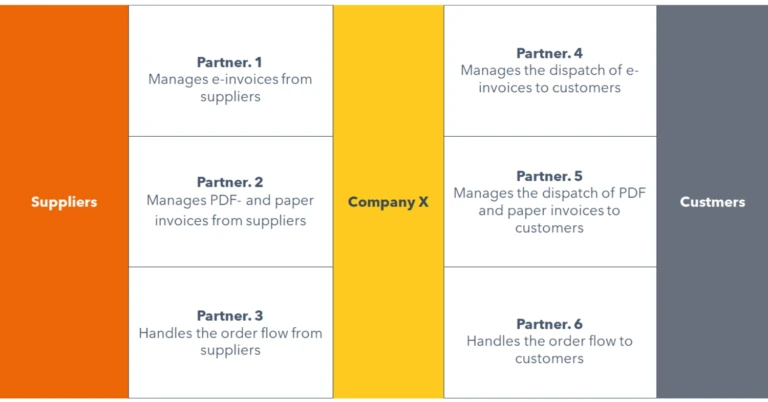
We have examples of worst-case scenarios where companies have up to six different partners for different flows.
Per Åberg, Head of Business Network Products, OpusCapita
Multiple Suppliers: Consequences to Consider
- Procurement/Contracting with Each Supplier:
Then you need to manage each contract.
With five different suppliers, you have to manage five different contracts.
With Peppol, only ONE procurement is required, and ONE contract.
- Multiple Integrations to Build and Maintain:
This results in more work for the IT department.
With Peppol, there is only ONE infrastructure to build and maintain.
- Multiple Support Contacts:
A single phone call to your main supplier is not sufficient if, for instance, orders or invoices get stuck. With multiple suppliers, contact with different support teams is required to resolve such situations.
With Peppol, you have only ONE contact.
- Use of Multiple Tools:
The need to learn and use multiple tools increases with more partners.
With Peppol, you have only ONE tool to monitor all processes.
- Being a Small Customer to Several Suppliers:
This diminishes negotiating power and potentially lowers service quality.
Compared to having one significant supplier where negotiating power and service levels increase.
- Lack of Process or Scale Benefits from Existing Infrastructure:
Let’s say you start with a supplier handling your electronic invoices. Then comes a day when you want to manage orders. It’s not guaranteed that the integration supports the expansion of messages. It’s crucial to assess whether the partner supports what you need today but also what you will need in 5 to 10 years.
With Peppol, processes support each other.
Peppol – a part of OpusCapita’s network
Peppol offers an advantage over point-to-point routings by establishing a unified standard for message handling. It uses a single format, BIS 3 according to EN 16931, allowing standardized structure and content in messages according to European classification. This common standard also covers communication protocols and addressing.
In our delivery network, this means that, with Peppol, we can handle files from customers in a unified manner. By using the common communication protocol, we easily locate the recipient’s access point and can smoothly send messages to them. This eliminates the need for complex integrations or communication with multiple operators, resulting in efficient and secure communication as long as the message is correctly validated and contains relevant information for the Peppol-connected recipient.
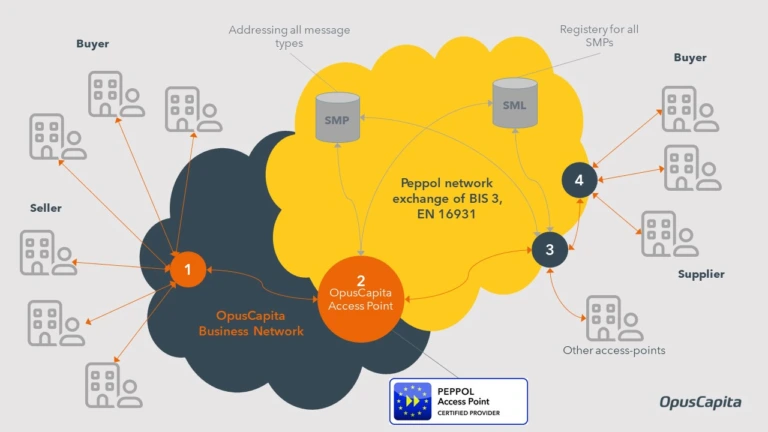
So, this is how Peppol orders in Sweden look in practice
Let’s say it’s your company on the right, acting as the supplier with your business system.
The business system can be, for example, a direct Peppol file, Peppol BIS 3 file, UBV, Invoice, SAP, a form of iDoc XML, Microsoft XML, or IFS XML.
We receive and map data where we already have prepared formats to facilitate the exchange over Peppol. We only need data that fits these formats to send messages. If recipients and users are not specified in the file, we use a dynamic routing service to identify the right partners. We continuously convert files into different supported message formats, such as:
- Catalogues
- Orders
- Order responses
- Despatch advices
- Invoices
Peppol eliminates the previous need for unique integrations and different formats for each party. Instead, it offers a simple connection to predefined message formats and an existing network. As long as the parties are connected, Peppol enables smooth message exchange without the need for complex customizations or lengthy setup processes
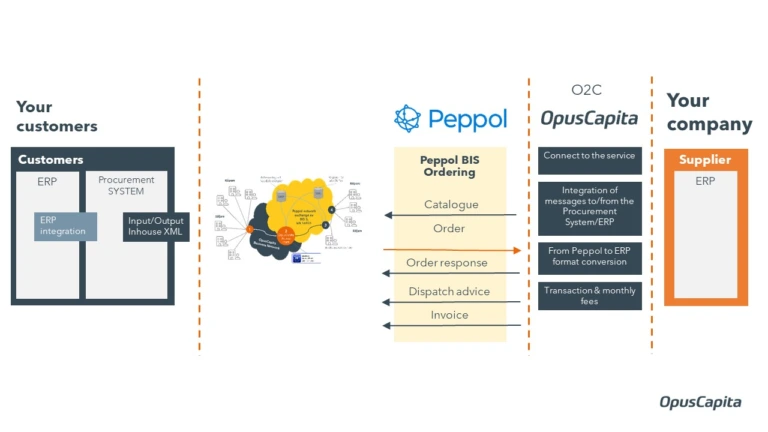
The same principles and methods apply to procurement
Your procurement system and ERP connect to the service where we receive and convert data formats into Peppol documents, including catalogs, orders, order responses, despatch advice, and invoices. This enables exchange with your suppliers, even those unable to handle electronic formats, and can instead use portals for manual Peppol orders.
OpusCapita facilitates the process by managing catalogs, orders, order responses, and invoices in a cloud-based solution over the Peppol network for suppliers that cannot technically or commercially handle electronic orders.
This method also eases the process for smaller suppliers without Peppol. Through the interface, they can manage received orders, create despatch advice, and send invoices, allowing for a seamless process within the same cloud-based solution.
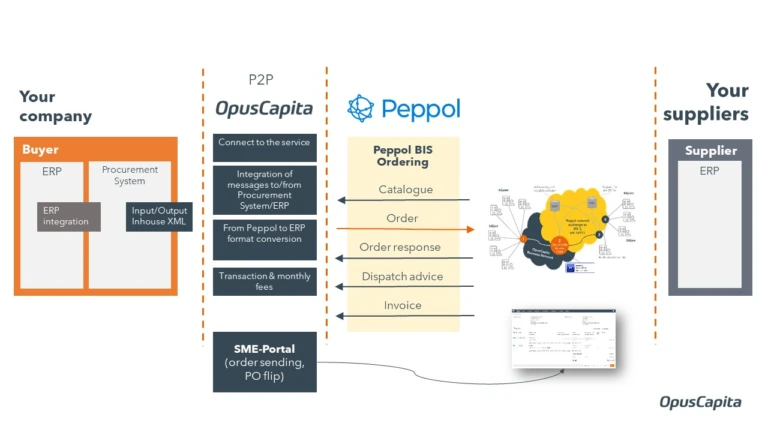
Checklist: Key Resources for Successful Automation
We have created a checklist to identify essential resources in the organization to successfully drive an automation project. You need:
- A change leader:
Responsible for driving changes and ensuring a smooth transition to new processes and systems.
- A process owner per unit/company/country:
A dedicated person per unit or country is responsible for governing and optimizing processes internally, streamlining IT coordination, and maximizing the benefits of the investment.
- An expert in invoice/order automation:
A specialist with in-depth knowledge of automating invoice and order processes.
- An e-invoicing and e-order specialist:
An expert in managing and optimizing e-invoicing and e-order processes.
- A leader for campaigns/initiatives:
The person leading and driving various campaigns and initiatives in the automation area.
Collaboration instead of isolating departments is crucial. Shared solutions require cooperation to be achieved.
Per Åberg, Head of Business Network Products, OpusCapita
Succeeding with Peppol: Transparent Information on the Website
For successful work with Peppol, it is crucial to clearly communicate on the website the available invoice and order methods, along with connection instructions for customers and suppliers.
Express, for example: “We have chosen Peppol for seamless sending and receiving of business messages. We receive these business messages. Do you, dear customer, want to join our journey? Follow these simple steps to connect.”
Two excellent examples of companies using Peppol orders in Sweden that communicate this well on their websites are Södertörn University and the Police.
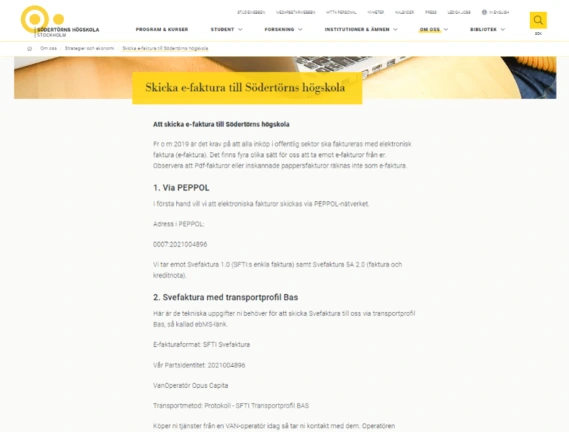
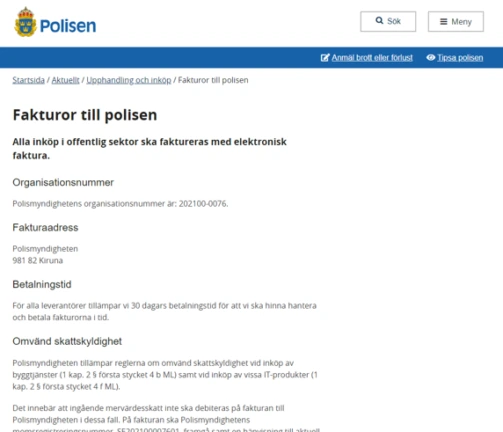
Optimize Your Flows with OpusCapita
OpusCapita automates incoming and outgoing order and invoice flows to streamline business processes with customers, suppliers, and logistics partners. Our network is connected to Peppol and approximately 60 similar operators globally. We handle a multitude of transactions daily and assist customers in several countries in streamlining their business flows. If you are looking for a partner to optimize your flows, we are here to help. We support you with the framework, and the required activities, and collaborate with you to implement them.

If you are looking for a partner to optimize your flows, we are here to help.
We support you with the framework, and the required activities, and collaborate with you to implement them.


